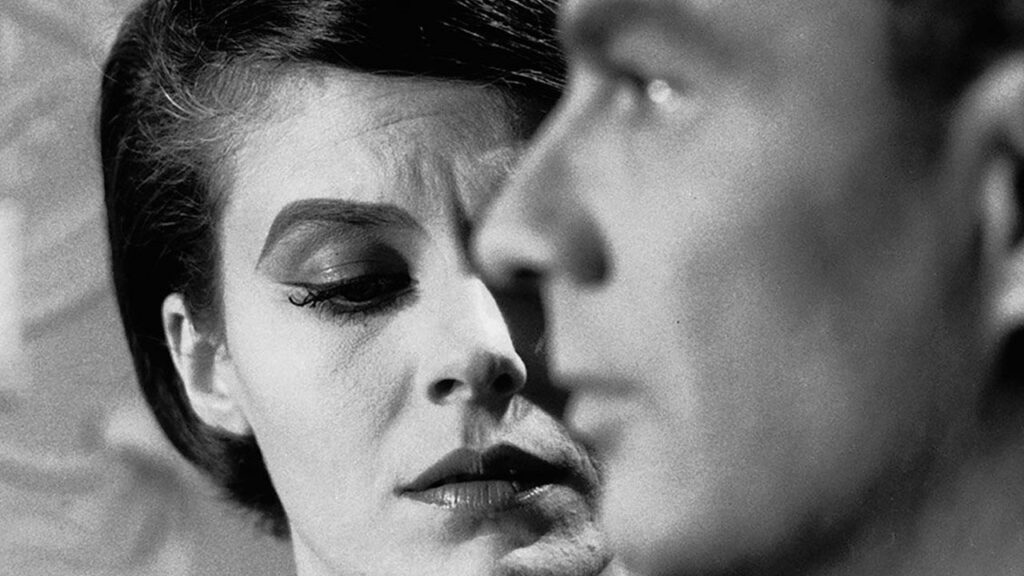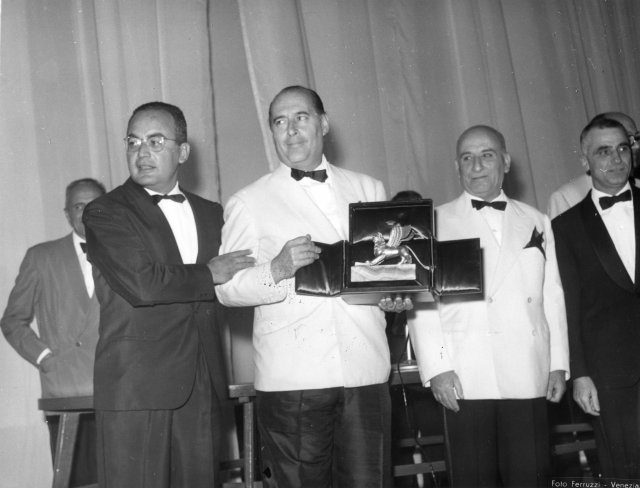The 50s
The war is over, Italy is a Republic born from the values of the Resistance against Nazi-Fascism, everything has changed… but perhaps not too much. For the Venice Film Festival, which restarted in 1946 with the direction of Elio Zorzi (who will remain until 1948), the challenge is still to defend its margin of autonomy from the interference of political power. The Christian Democrats, who won the ’48 elections and would lead the country for over fifty years, did not change the Biennale’s 1938 Statute, which made the institution dependent on the central government.
The directors of the 1950s (Antonio Petrucci, Ottavio Croze and Floris Luigi Ammannati) would thus have to juggle balances that the onset of the Cold War made particularly delicate (Soviet films were absent from 1948 to 1953), with the constant fear of the Festival’s displacement to Rome. Critical moments include the withdrawal from the competition in 1955 of the stingers El canto del gallo, Blackboard Jungle and Jan Hus and Catholic protests over the admission in 1958 of Louis Malle’s “scandalous” The Lovers.
This did not prevent the Festival from relaunching itself and regaining centrality in the imagination. Merit also goes to critic and member of the Mostra’s selection committee Francesco Pasinetti (who died in 1949). A key moment was the 1947 edition, in the Doge’s Palace in Piazza San Marco (from the following year it would return to the Lido), defined by Callisto Cosulich as the “most important event that the Festival has experienced from its foundation to the end of the twentieth century.” In his book La Mostra Internazionale d’Arte Cinematografica di Venezia 1932-2022 Gian Piero Brunetta writes that you can find “that air of crossroads and cosmopolitan dialogue of cultures that the war had interrupted.” In 1950 the Lido became a center of the new Italian “Dolce Vita,” with an unprecedented number of stars, including Ingrid Bergman, Barbara Stanwyck, Vittorio De Sica and Roberto Rossellini.
Controversy also returns: among others, over the undervaluing of neorealist masterpieces, from Rossellini’s Paisà (1946) to Luchino Visconti’s La terra trema (1948), to which the jury preferred Jean Renoir’s The Southerner and Laurence Olivier’s Hamlet, respectively. Our best cinema will have its revenge in 1959, with the double Golden Lion to Monicelli’s La grande guerra and Rossellini’s Il generale Della Rovere. But at the Lido Visconti would continue to be synonymous with heated disputes between aesthetics and politics, particularly with one of the most incandescent award ceremonies the Festival remembers, that of 1954, where Renato Castellani’s Romeo and Juliet won the Golden Lion and Senso was ignored by the awards.
In these years, however, the Venetian scene is taken also from some of the great cinematographies from the world, such as the Japanese (with Akira Kurosawa’s Rashomon beating A Streetcar Named Desire in 1951), the Scandinavian (Carlo Theodor Dreyer’s Ordet, Golden Lion in ’55, Ingmar Bergman’s The Face, Special Jury Prize in ’59) and the Indian (Satyajit Ray’s Aparajito, 1957). So much shortsightedness toward Alfred Hitchcock, who opens in ’54 with one of his masterpieces, Rear Window, called “stupid” and “grotesque” by American critic Weinberg.
Future masters such as Stanley Kubrick, who debuted in 1952 with Shape of Fear (later Fear and Desire) and Federico Fellini, in the same year with Lo sceicco bianco, then with I vitelloni and in ’54 with La strada, Silver Lion. Among the great regrets of the time, however, was not having Charlie Chaplin and his Limelight for the 20th anniversary of the Venice Film Festival in ’52, an endeavor for which Vittorio De Sica also spent himself in vain.
The 60s: changes between reform and revolution

Renewal is what is at stake for the Venice Film Festival in the 1960s, marked by transformations in both (not only) Italian society and cinema. On this front, starting with the French Nouvelle Vague, movements and personalities of rupture also emerged in our country, which experienced the season of the economic boom and experimented with the center-left formula with the entry of the Socialist Party into government.
The changes invest the Festival, after a 1960 edition (directed by Emilio Lonero) where protests still saw Luchino Visconti at the center: “A long and vigorous chorus of whistles, howls, shouts and cries of “Vis-con-ti!”, “Vis-con-ti!”,” according to Dino Buzzati’s chronicle, welcomed the failed Golden Lion to Rocco and His Brothers in favor of The Rhine Passage.
But times are changing, as the next two editions, directed by Domenico Meccoli, already show: Alain Resnais’s Last Year at Marienbad won in 1961 and as Gian Piero Brunetta recounts in his book on the history of the Mostra it “struck the critics of the daily press so off guard that they seemed, on leaving the reserved screening, to be veterans of three rounds in the ring with Cassius Clay.” Another great and divisive filmmaker, Pier Paolo Pasolini, then made his debut on the Lido with his Accattone, although the real outsider was perhaps the doc All’armi siam fascisti! by Cecilia Mangini, Lino Del Fra and Lino Miccichè, so politically acuminated that the filmmakers were obliged to rent the hall in which to screen it.
The 30th anniversary of the Venice Film Festival in 1962 kicked things up a notch: among the titles in competition were Stanley Kubrick’s Lolita (“excommunicated” by the patriarch of Venice), Pasolini’s Mamma Roma, Jean-Luc Godard’s Vivre sa vie and Andrei Tarkovsky’s Ivan’s Childhood, Golden Lion ex aequo with Valerio Zurlini’s Cronaca familiare. Luigi Chiarini (from the socialist area and former director of the Centro Sperimentale di Cinematografia) was the Jury president that year. He took over the reins of the event from the following year. For Brunetta it is “the beginning of a phase in which a director takes on a divine air,” promoting to an unprecedented degree “wide-openings and discoveries and rediscoveries.”
Italian cinema capable of combining spectacular force with the courage of political denunciation is a protagonist, with the Leone d’oro to Francesco Rosi’s Le mani sulla città (1963) and Gillo Pontecorvo’s La battaglia di Algeri (1966), hence the defection of the French delegation and the apology of Foreign Minister Fanfani. No less important were the consecration of Michelangelo Antonioni (and Monica Vitti) with the victory of Il deserto rosso, the Special Prize, in the same year, for Pasolini’s Vangelo (ex aequo with the Soviet Kozintsev’s Hamlet) and, finally, the recognition of Visconti for Vaghe stelle dell’orsa (1965). Also among the many debuts was Marco Bellocchio’s with I pugni in tasca.
The season culminates in 1967 with the triumph of the anti-bourgeois and dreamlike Luis Buñuel for Belle de jour. And it implodes the following year, when the “reformist” Chiarini goes to the clash with the revolutionaries of ’68 (in the forefront the Association of Filmmakers ANAC), who, on the wave of similar protests from Cannes to Pesaro, promote a boycott of the initiative calling for a radical democratization of the Festival and the film industry. Thus, despite disruptive titles such as Pasolini’s “Missed Golden Lion” Teorema, Liliana Cavani’s Galileo and Carmelo Bene’s Nostra Signora dei Turchi, the 1968 edition, amid occupations, assemblies, batons, fascist beaters and resignations, sanctioned the end of an era. And nothing will ever be the same again.

